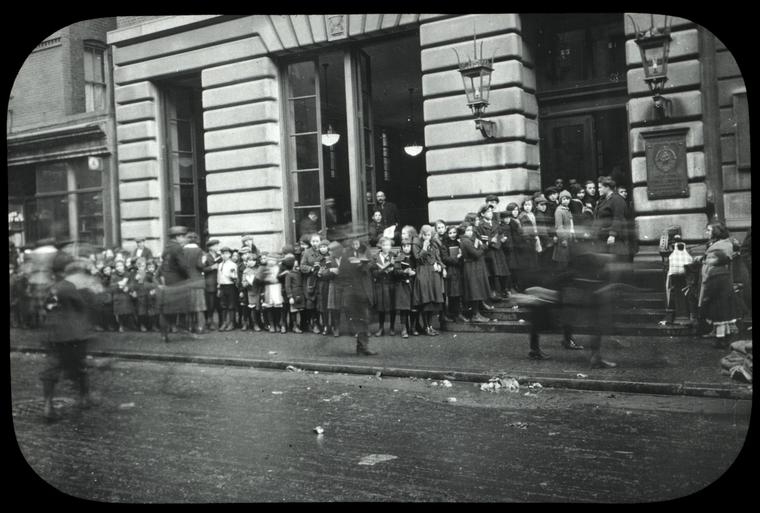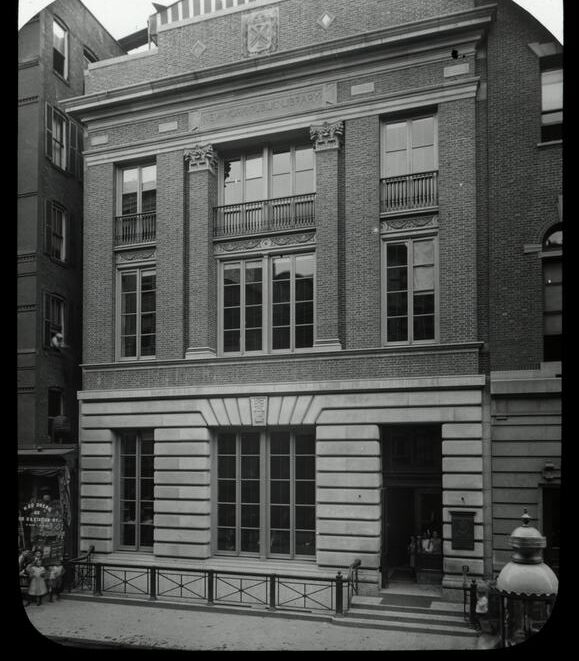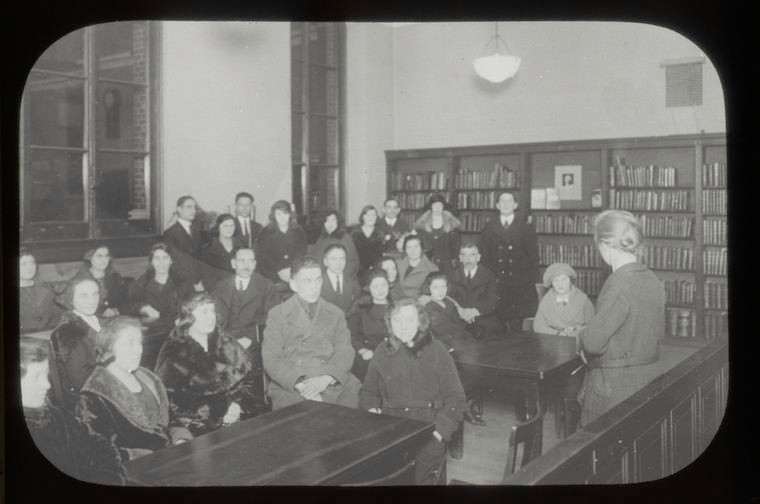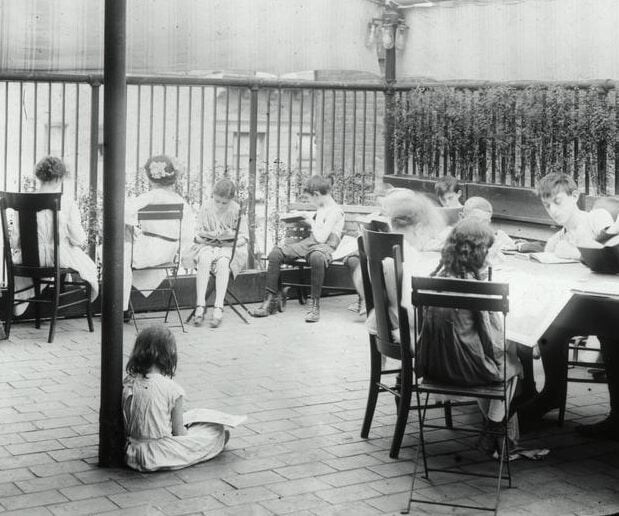Far more than just repositories for books, public libraries serve and have served a wide variety of purposes and populations, from borrowing books to internet access, services that are being sorely missed because of closures due to the pandemic. While the public libraries of the early 20th century didn’t have Wi-Fi, they were still integral parts of the community. Let’s take a historical look at how, through the former Rivington Street branch of the New York Public Library, in the Lower East Side.
Great Reads, New York City History
The Rivington St. Library
August 5, 2020

Line of children outside the library waiting to get in.

Nestled in between Allen and Ludlow streets, and standing at about three stories tall, the Beaux Arts-style building with its symmetrical façade was designed by the firm of McKim, Mead, and White (the architects behind the Columbia campus, Brooklyn Museum and countless other buildings). Opened to the public on June 10th, 1905, it was one of nearly 1,600 free libraries in the Unites States funded by steel magnate Andrew Carnegie, who believed that free and readily available access to information could broadly help individuals succeed in life.
The library also stands just next door to the University Settlement House, another neighborhood mainstay for community support. The relationship between the two buildings extends past their physical proximity, however. The announcement of the library’s opening in the Bulletin of the New York Public Library notes that the branch was originally located inside the settlement house and a contemporary plaque in front of the structure today notes how, in “1905: University Settlement’s 6500 books inaugurated the collection of the Carnegie ‘Free to All’ Library next door at 61 Rivington.”
To better serve the community around it, this collection would eventually contain works in Russian, Yiddish, Romanian and Polish. But past its polyglot stacks, the library found other ways to get involved in the neighborhood. One photo in the NYPL digital collections shows a lecture on citizenship to a “newly organised” group of immigrants, while a 1915 ad in La America, a Sephardic newspaper, notes free English language classes three times a week. A librarian in the 1910s, Mary Frank went further, speaking Spanish to many of the Sephardic children, much to their surprise. Rather than Yiddish, many Sephardic immigrants spoke Ladino, a mixture of Spanish and Hebrew and so despite the odd word or phrase it seems like the two were able to communicate.

After its time as a library, the former branch was home, for a time, to the New York Church of the Nazarene before it was purchased in May of 2018 by a real estate developer with plans to build an 11-story apartment building, repurposing its unique façade. The project is still under construction.

The Rivington branch might be long gone but libraries continue their work into the modern day. As a place for a student to catch up on homework, a job seeker to fill out an online application, a toddler and parent to listen to a story read aloud, or a community cooling center for the many un-air conditioned homes in NYC, they are focal points of the neighborhoods and many eagerly await when their doors can be flung open again.
Written by Jakub Gaweda, Tenement Museum Education Specialist
Sources:
New York Public LibraryBulletin of the New York Public Library, Astor, Lenox and Tilden Foundation. Volume IX No. 7 1905, pg. 246, 412. Retrieved from https://babel.hathitrust.org/cgi/pt?id=mdp.39015035117400&view=1up&seq=7
New York Public Library, Handbook of the New York Public Library. 1916, pg. 57. Retrieved from https://www.gutenberg.org/files/27954/27954-h/27954-h.htm
Ben-Ur, Aviva. Sephardic Jews in America: A Diasporic History. New York and London: New York University Press, 2009, pg. 79, 151.
OPEN-AIR LIBRARIES FOR THE CITY’S POOR, New York Times, April 24th 1910, pg. 8.
Historic NYPL Rivington Street Branch Undergoes Condo Coversion, Bowery Boogie, November 12th 2018 retrieved from https://www.boweryboogie.com/2018/11/historic-nypl-rivington-street-branch-undergoes-condo-coversion/
Images:
New York Public Library Archives. Rivington Street, children lined up outside branch. NYPL digital Collections, Retrieved from https://digitalcollections.nypl.org/items/510d47d9-81ff-a3d9-e040-e00a18064a99
New York Public Library Archives, Rivington Street, exterior view, of Rivington Street Branch. NYPL Digital Collections. Retrieved from https://digitalcollections.nypl.org/items/510d47d9-81fb-a3d9-e040-e00a18064a99
New York Public Library Archives. Rivington Street, lecture on citizenship to a newly organised group of immigrants. NYPL Digital collections. Retrieved from https://digitalcollections.nypl.org/items/510d47d9-81f6-a3d9-e040-e00a18064a99.
New York Public Library Archives, Rivington Branch, 61 Rivington St. Rivington Roof. NYPL Digital Collections. Retrieved from https://digitalcollections.nypl.org/items/510d47dd-e1ee-a3d9-e040-e00a18064a99